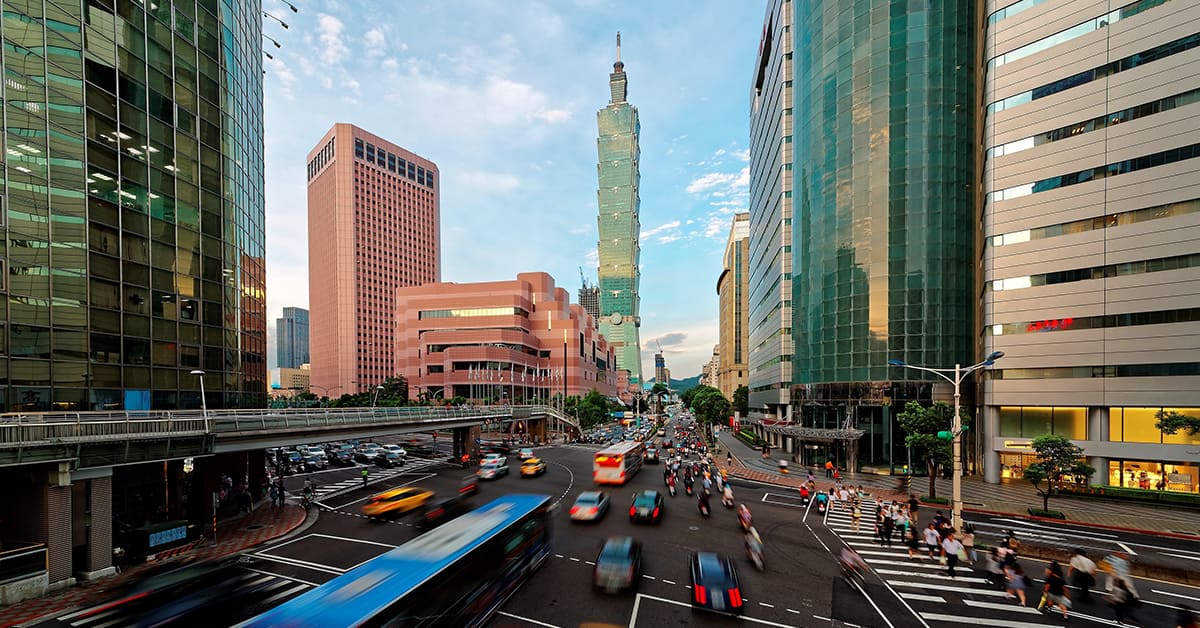As the world’s leading semiconductor manufacturer, Taiwan is on course for significant growth.

Taiwan has long presented as a paradox: a fragile entity from a geopolitical perspective, regarded as a renegade province by China and ripe for repatriation to the mainland. Meanwhile, it also is an economic dynamo, powered by its unrivaled semiconductor industry and vital to the global supply chain. Success and insecurity epitomize Taiwan, presenting a tantalizing risk proposition.
“We reflect the complex relations between Taiwan and mainland China and their potential economic and political shocks in our rating assessment for Taiwan in the form of a downward one-notch qualitative overlay adjustment, which is a measure of nonquantifiable inputs such as the risk of invasion,” says George Xu, APAC associate director of Sovereign Ratings at Fitch Ratings in Hong Kong.
Under the leadership of Tsai Ing-wen, elected president in early 2016, the situation is less than stable due to the persistent saber-rattling of its mighty neighbor, which may yet result in the island’s invasion. Cross-strait tensions are projected to rise in November as local elections are held on the island.
Putting China’s sword of Damocles aside, Taiwan impresses with its ambition, encapsulated in policy and regulatory action in areas such as environmental, social and governance (ESG), foreign direct investment (FDI) and financial services. And it’s spreading its wings in the international debt capital markets thanks to its dynamic Formosa bond market, which promises to be a regional green finance anchor in the APAC region.
Taiwan’s administration promotes a core economic growth policy led by increases in domestic investment and FDI, but there are lingering constraints due to the country’s public debt ceiling, which is limited to 50% of GDP under the 1996 Public Debt Act.
Despite that constraint, Taiwan has ticked most of the boxes over the past few years and weathered the pandemic impressively.
According to preliminary figures, Taiwan’s GDP grew 6.3% in 2021 and is expected to grow 2.8% this year, which is lower than expected, says Lim Him Chuan, Taipei-based general manager and CEO of DBS Bank in Taiwan.
“The Taiwanese government has done a great job in controlling Covid and we expect domestic demand to pick up this year,” he says. “Of the four so-called Asian Tiger economies—Hong Kong, Singapore, South Korea and Taiwan—Taiwan is likely to outperform, boosted by its semiconductor industry, which is crucial to global supply chains and which will thrive on the back of expected 8.8% growth in the global semiconductor market this year, boosted by smartphone demand in the switch to 5G technology, and other areas such as smart factories.”
Him Chuan also notes another significant dynamic within Taiwan’s crucial semiconductor industry: “Capital spending by the big Taiwanese semiconductor companies is expected to be strong and cash flow will be boosted by the 10% hike in chip prices led by TSMC, UMC and PSMC.”
Taiwan’s real estate market, which is buoyant due to low domestic interest rates and high levels of liquidity, has provided significant support for the island’s economy, he adds.
FDI Gains Steam
Foreign direct investment continues to pick up, partly due to a reshoring policy adopted in 2019 to encourage Taiwanese companies to move operations from China back to the island. Taiwan’s FDI remained strong last year at about $8.8 billion, and market data provider Trading Economics predicts it will hit $9.5 billion this year.
“The government has approved more than 1.6 trillion new Taiwan dollars (approximately $57.6 billion) investment by local firms as of the end of 2021 under the policy schemes launched in 2019 to promote reshoring. The continued reshoring has been one of the drivers behind Taiwan’s strong private sector investment over the past year,” says Fitch’s Xu.
Meanwhile, private equity (PE) investment in Taiwan remains one of the lowest in Asia, with PE firms listing regulatory volatility, lack of transparency and excess administrative discretion as impediments to entry.
There have been frequent complaints that the government’s attitude toward PE is inhibitory. It displays an apparent reluctance to allow large, prestigious local names to be delisted from the main equity exchanges and something of a prejudicial mindset towards the PE modus operandi, which potential investors view as having a short-term focus and a posting risk to minority shareholders.
“A long-standing challenge has been the lack of transparency and regulatory clarity, particularly in sectors that are sensitive but still allow foreign ownership,” says Isaac Poole, global chief investment officer at asset manager Oreana Financial Services in Hong Kong.
In Taiwan, PE transactions in recent years have focused on the technology, media and telecommunications industries. Some of the standout deals include MagiCapital Group’s take-private acquisition of On-Bright Electronics and Ilitek; KHL Capital’s investment in telco Taiwan Star; and AMP Capital’s investment in wind farm developer Swancor Renewable Energy.
“Our 2022 outlook for Taiwan is sanguine, based on a 3.3% growth forecast,” says Tim Uy, senior economist at Moody’s Analytics in Hong Kong. “As long as Taiwan continues to manage the spread of Omicron, we do not foresee supply chain disruptions significantly hampering production or slowing consumption.”
“We believe Taiwan will continue to lead the world in the production of leading-edge chips, and for electronic exports to continue to power Taiwan’s growth.”
Growing Green
Sitting as a tech hub for Asia and the world, and in the middle of complex supply chains, Taiwan has a natural requirement to adopt a multistakeholder approach to corporate governance, which may help explain the growth of ESG culture on the island.
Taiwan is ranked first in terms of ESG disclosure in Asia, according to think tank CSRone. Governance and sustainability considerations, in line with the UN’s Sustainable Development Goals, are core principles for the island’s corporations and are the partial result of regulatory moves made by the Taipei Stock Exchange and Financial Supervisory Commission over the past decade or so.
“Taiwan has been on the right path from day one regarding ESG, without any overwhelming pressure coming from the regulators,” says Elsa Pau, founder and CEO of BlueOnion, an ESG-focused, Hong Kong–based fintech portal. “The country has been excluded from the UN and other frameworks in the past, but they are catching up and they are taking a closer look at international frameworks for alignment.”
All of the focus on sustainability bodes well for FDI and for Taiwan’s capital markets, where increas-ingly aligning with international standards and taxonomies is vital to attracting institutional capital into sustainable financial products.
Underlying these trends is the key industrial reality on the ground: Taiwan is undergoing a green energy revolution. It is in line with Taiwan’s commitment to reach net-zero carbon emissions by 2050, a goal which President Tsai unveiled in April 2021. As part of its plan, the island aims to cut its reliance on nuclear power, which accounts for 15% of its electricity generation, along with fossil fuel imports. It aims to ramp up renewable energy to 20% of the nation’s power supply by 2025.
The 2019 Renewable Energy Development Act requires Taiwan to reach these goals as well as install 27 gigawatts of renewable energy capacity comprised of solar, off- and onshore wind, hydroelectric and biogas generation.
The potential for foreign participation is immense, given a relatively stable pricing backdrop and the availability of transparent off-take agreements whereby state-owned Taiwan Power Company is obliged under the feed-in tariffs scheme to enter into 20-year power-purchase agreements for renewably generated energy.
Innovation in Taiwan’s green finance sector beckons, exemplified by the August 2021 trade for Sing Da Marine Structure Corporation (SDMS) arranged by Crédit Agricole CIB. A green guarantee was inaugurated, part of 5 billion new Taiwan dollars (approximately $179 million) of renewed facilities comprising two tranches: a green technical guarantee and a green commercial paper guarantee, which the latter is the first of its kind in Asia-Pacific region.
The green facilities are associated with the green project of Danish infrastructure company Ørsted’s Greater Changhua offshore wind farm, which will be instrumental in avoiding the generation of 988,000 metric tons of greenhouse gas emissions annually from Taiwan.
SDMS, a 100%-owned subsidiary of China Steel, plays a crucial role in the localization of Taiwan’s wind-generated power supply chain. The green guarantee represents a best-practice precedent for green finance in Taiwan, and for other industrial players, to pioneer green finance in the renewable energy sector.
“Crédit Agricole CIB is committed to supporting our clients in accomplishing their sustainability strategies through green trade finance products,” says Benjamin Lamberg, Crédit Agricole’s CEO for CIB’s Taiwan branch. “The deal represents a major milestone both for accelerating the environmental impacts green trade finance products can bring about, as well as matching our clients’ green financing needs.”
“Drawing from our global experience in the structuring of green financial products, Crédit Agricole CIB will continue to work toward innovating and expanding the greenification and ESG integration of financial products in Taiwan and the region,” adds Carmen Tsang, head of Sustainable Banking for Greater China at Crédit Agricole’s CIB.
High-profile clients like Apple, and other overseas buyers who have high sustainability targets, have been critical drivers for Taiwan and companies to adhere to ESG standards, according to DBS’ Lim. “DBS in Taiwan is enhancing the ESG dynamic through the provision of sustainability-linked loans and green deposits.”
Meanwhile, global corporate treasurers would do well to put Taiwan’s Formosa bond market—issuance brought in Taiwan by foreign entities and denominated in offshore currency—on their radar, particularly those with an eye on a green-labeled format. The market has established itself as a standout, given its ability to absorb ultralong-dated, callable paper, often in zero-coupon format.
Onshore liquidity is abundant, and Taiwan’s investors held more ESG-aligned mutual funds and exchange-traded funds as a proportion of assets under management than any other Asian country in 2020, according to a 2021 Fitch Ratings report.
The potential for diversifying the investor pool via Formosa bond issuance is immense, not only by tapping the powerful onshore bid but also further afield, given the high uptake for Formosa issuance in Regulation-S format by international investors seen in recent deals. This is illustrated by State Bank of India’s debut $300 million trade in mid-January, of which 85% went to accounts based in Asia, Europe, the Middle East and Africa.
At the same time, the potential for green issuance in Formosa format is immense, with financial institutions having been first to leverage the product.
In August 2021, DBS Group signed a three-year, $200 million sustainability-linked loan with Formosa Ha Tinh (Cayman) Limited, marking one of the largest deals in sustainable development within Taiwanese companies.
During the same month, Deutsche Bank printed the first of two $200 million labeled green deals, while printing the second in mid-October.
“ESG is becoming increasingly important to Taiwanese investors, particularly the life insurance companies that have a particularly sharp focus on that investment discipline,” says Edward Tsui, head of APAC Debt Syndicate & North Asia Debt Capital Markets at Deutsche Bank in Hong Kong. “For issuers looking at long-dated callable paper, it’s the core market for offshore currency bond issuance.”



